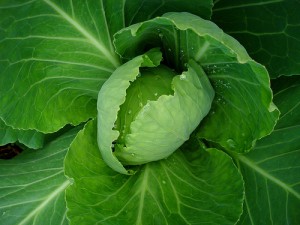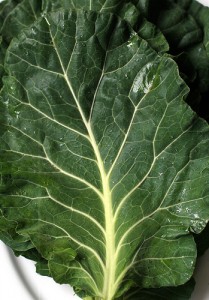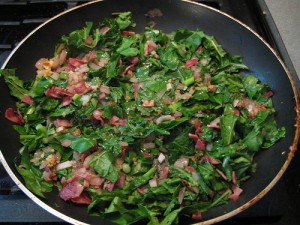One of the most common reactions I hear from folks who are new to the low oxalate diet is “What do you mean I can’t eat spinach? But spinach is sooo good for you! How can this low oxalate diet be healthy?” Well, I have some good news and some bad news. First, spinach is not good for YOU (although it might be okay for some other people with rock solid digestive tracts and little endogenous oxalate production). I know it can be hard at first, but just let spinach go if you haven’t already. Spinach is not your friend, and you don’t need it to be healthy. Second, you can eat lots of fabulous, nutritious greens on the low oxalate diet, including dino kale, mustard greens, water cress and turnip greens. In fact, many of these greens have a much better nutritional profile than spinach, plus the calcium and other minerals in low oxalate greens are more bio-available than those in high oxalate greens because there isn’t a lot of oxalate binding the minerals up in your gut. Yay! This low oxalate diet is sounding better all the time, isn’t it?
Since so many people grow up eating only three leafy greens (lettuce, spinach and cabbage) and aren’t familiar with the huge array of fabulous and nutritious greens available on the low oxalate diet, I put together the guide below to help you use medium and low oxalate greens more confidently. Are you ready to experiment?
Making a soup? Try adding a handful of mustard greens, pea greens or American cress (see Chicken Sausage Soup with Mustard Greens and Mushrooms for one of my favorite soup recipes). Craving a salad? Try adding some arugala, kohlrabi or water cress for a peppery bite. Want to try your hand at fermenting? Use a tough green like mustard greens, cabbage or broccoli rabe. Just want some comfort food? Make a pot of southern-style low oxalate greens with turnip greens or collard greens. Have fun trying something new!
How to Read the Tables: Very low oxalate greens have less than 1 mg. oxalate per half cup and are marked in the low oxalate list with an asterik. Low oxalate greens have 1- 5 mg. oxalate per half cup. Medium oxalate greens have 5 -15 mg. oxalate per half cup. All oxalate values are for one half cup raw greens unless otherwise stated. Oxalate values for cooked greens are measured after cooking. For example, if the oxalate value is for boiled greens, this means that the greens were boiled for at least 6 minutes and the cooking water has been thrown out or used to water the house plants. Please note in the cooking section I have included all common or tasty cooking methods for each green, although we don’t have oxalate values for all cooking methods. Use the raw value and measure before cooking if I haven’t listed a value for the cooked green.
Sources: All oxalate values in these tables come from the Autism Oxalate Project or the VP Foundation’s oxalate testing programs and were either tested in Dr. Michael Liebman’s laboratory (University of Wyoming) or reviewed by Dr. Michael Liebman for the Low Oxalate Cookbook 2.
Low Oxalate Greens: Medium Oxalate Greens:
Mustard Greens (boiled) Collard Greens (boiled or steamed)
Cabbage (nappa, purple, green, savoy) Belgian Endive or Chicory
Bok Choy Grape Leaves
Turnip Greens (boiled) Broccoli Rabe/Rapini(steamed)
Dino/Lacinato/Tuscan Kale (boiled) Dandelion Greens (raw or boiled)
Lettuce (Cornsalad, Iceberg, Bibb) Mustard Greens (steamed)
Lettuce (Romaine, Butter, Boston)* Turnip Greens (steamed)
Broccoli Rabe/Rapini Curly Kale
Collard Greens Green onions (green part)
Creasy/American Cress (boiled) Shallots
Pea Greens Broccoli (steamed)
Arugula* Fennel (raw or boiled)
Alfalfa Sprouts Brussel Sprouts (steamed or boiled)
Water Cress (raw or boiled)
Kohlrabi*
Broccoli (raw or boiled)
Mild-Tasting Greens: Zesty or Spicy Greens:
Turnip Greens (when cooked) Turnip Greens (spicy/bitter when raw)
Collard Greens Mustard Greens* (bitter when raw)
Dino Kale Dandelion Greens
Curly Kale Arugula
Pea Greens Broccoli Rabe/Rapini (bitter when raw)
All LO Lettuces Green Onions
Alfalfa Sprouts Shallots (raw)
Fennel (mild but flavorful) Water Cress
Shallots (sauteed) Kohlrabi
Broccoli American Cress
Brussel Sprouts
Greens to Eat Braised or Steamed: Greens to Eat Boiled:
Mustard Greens Turnip Greens
Turnip Greens Collard Greens
Collard Greens Curly Kale
Dino Kale Dino Kale
Curly Kale Mustard Greens
Bok Choy Broccoli Rabe
Belgian Endive (light heat only) Collard Greens
Broccoli Rabe Water Cress (in soups)
All Cabbages Dandelion Greens
Broccoli Broccoli
Water Cress (light heat only) Fennel
Fennel Pea Greens
Pea Greens All Cabbages
Brussel Sprouts Brussel Sprouts
Greens to Eat Raw: Greens to Ferment:
All LO Lettuces All Cabbages
Bok Choy Bok Choy
All Cabbages Grape Leaves
Arugala Mustard Greens
Dandelion Greens Kohlrabi
American Cress Turnip Greens
Belgian Endive Broccoli Rabe/Rapini
Broccoli Collard Greens
Alfalfa Sprouts Dino Kale
Water Cress Broccoli
Fennel (leaves especially) Fennel (bulb)
Curly Kale
Best Spinach Substitutes in Recipes:
Dino Kale (cooked)
Turnip Greens (cooked)
Romaine Lettuce (raw)
Washing Low Oxalate Greens: The easiest way to wash greens is to fill a sink or large mixing bowl with water and submerge the greens, gently swishing them around. If sediment falls out, pour out the water and wash one more time. Salad dressings won’t stick to wet greens, so let them dry before eating in salads (you can spread them out on cloth or paper towels to dry faster or pat them lightly with a dish towel).
Preparing Low Oxalate Greens: If the stems are small and bend easily you don’t have to remove them. If you are using tougher greens with big stems, however, remove the stem and the rib (mustard greens, turnip greens and collard greens usually have to be de-ribbed). Tear or cut the greens into bite-sized pieces.
Braising Low Oxalate Greens: Most greens benefit from low to medium heat vs. high heat and light braising versus long cooking. Try using grass-fed butter, coconut oil, olive oil or bacon fat for your braising fat (2-4 tablespoons for a big skillet of greens). Toss the greens around in the skillet for a few minutes until they are done (taste as you go –braised greens are done when you think they taste done!). If your are using tougher, “big-leaved” greens, you may need to put the lid on for a minute or two and let them steam. Add a little salt, garlic or vinegar for seasoning at the end and enjoy. Yum!
Boiling Low Oxalate Greens: Make sure the greens are submerged and boil for 6 – 10 minutes depending on the green (it might take a few minutes for the greens to “boil down” enough to all fit in your pot and be submerged). You want it to boil long enough to cook the green and leach out as much soluble oxalate as possible, but not so long that you are left with a limp, mushy pile. Boiled greens are delicious seasoned with salt, garlic salt, white pepper, butter, vinegar or olive oil.
Fermenting Low Oxalate Greens: This is a post all of it’s own! I’ll be experimenting this summer and reporting my results in follow-up posts, so please check back.
Photo credits go to karendalziel for Braised Greens, to Steven Jackson for Collards and to Christian Guthier for Cabbage.



{ 62 comments… read them below or add one }